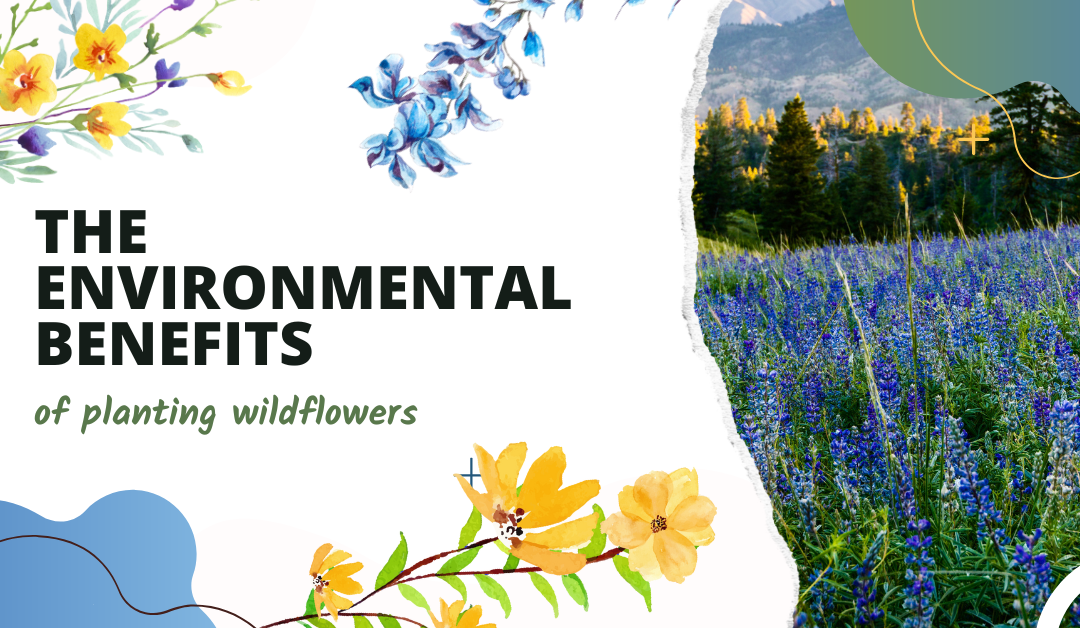Wildflowers are a natural way to add beautiful color and interest to your garden, but did you know that there are also environmental benefits of wildflowers?
Native wildflowers help support wild pollinators and the local insect pollination, which ultimately helps support other wildlife.
Let’s look at some of the many environmental benefits of wildflowers.
The Benefits of Planting Wildflowers
Wildflower meadows are havens for butterflies, bees, other pollinators, and beneficial insects. Along with being a food source for these creatures, wildflowers also help prevent erosion, support biodiversity and can even make excellent companion plants.
Here’s why everyone should consider planting wildflowers or doing their part to help protect them.
They Create Biodiversity
Wildflower meadows are excellent for biodiversity. A single meadow can be home to over 100 different species of wildflowers that help support wildlife.
- Their pollen is a food source for insects.
- Rodents eat their seeds.
- Hummingbirds consume their nectar.
- Reptiles eat their leaves.
- Grouse and chickens rely on wildflowers to keep their nests hidden in the spring.
The wildflower bird’s-foot trefoil alone is a food source for 160 different species of insects. These insects, in turn, help support bird and mammal populations.
Biodiversity is beneficial to all life on earth. To maintain healthy ecosystems, we need a variety of plants, animals and insects. Planting wildflower meadows can help support this goal.
They Attract Beneficial Insects and Pollinators
One of the biggest benefits of wildflowers is that they attract pollinators and beneficial insects. They help support declining honeybee populations with their pollen.
Many varieties of wildflowers attract pollinators, including:
- Oxeye daisy
- Bluebell
- Foxglove
- Dead-nettle
- Bird’s Foot Trefoil
- Comfrey
- Clovers
- Yarrow
- Cornflower
- Teasels
- Angelica
Most wildflowers will attract bees or butterflies, so feel free to choose varieties that you love. But do take some time to learn about the variety’s growing habits and whether they are native to your area. Certain types of wildflowers are considered invasive in some areas and not others.
If you have a home vegetable garden, attracting pollinators and beneficial insects will help keep your plants healthy and fruitful.
They are Great for Companion Planting
Many varieties of wildflowers are excellent companion plants. They either amend the soil by depositing nutrients or they deter pests.
Marigolds, for example, help repel beetles and benefit the growth of basil. Nasturtiums can attract predatory insects that kill aphids, which can help protect neighboring plants.
If you’re planting a vegetable garden this year, consider planting some wildflowers as companions to help attract pollinators and keep pests at bay.
They are a Food Source for Insects and Animals
Wildflowers serve as a food supply for butterflies, bees, pollinators and animals throughout the year. According to the World Wildlife Foundation, one acre of wildflower meadow can have 3 million flowers on any given day in the summer. Those flowers produce a whopping 1 kg of nectar, enough to support 96,000 honeybees daily.
Insects are critical to all life on earth because they pollinate food crops.
The insects attracted to these wildflowers also serve as important food sources for various animals.
And animals like the American Pika also depend on wildflowers for food.
They Hold Nutrients in the Soil – Which Can Help Prevent Flooding
A wildflower habitat can help prevent flooding because of its complex root systems, which help keep the soil stable and prevents erosion. Stable soil can hold onto rainwater and prevent nutrients from being washed away.
If you have a steep hill on your property, consider planting wildflowers to help prevent erosion, eliminate the need to mow these tricky areas and support local wildlife.
They Add Color and Beauty to Outdoor Spaces
Wildflowers add so much color and beauty to outdoor spaces, which can indirectly benefit the environment. Admiring wildflowers, whether in a natural meadow or your own backyard, can help make you more interested in protecting the environment and the insects and animals they support.
Final Thoughts
Wildflowers have many environmental benefits, from feeding wildlife to helping prevent erosion and flooding. Planting your own wildflower garden in your backyard is a great way to support the local ecosystem, but it’s important to make sure that you plant native wildflowers. If you’re new to gardening, look for wildflowers that are easy to grow and maintain.
Rene is a creative, little gnome. When she's not diving deep into research on health and wellness, she's spending here time out in nature, growing her homestead, photographing wildlife, doing yoga or enjoying a zen (depending on the day) moment with her fur babies. And on top of all of that, she's a professional writer by day, helping businesses around the world grow.

